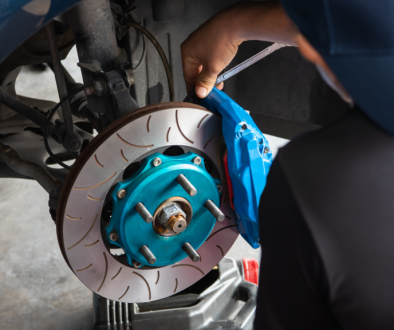Let’s face it—winter isn’t kind to trucks. From freezing temperatures to icy roads, winter conditions put extra strain on every part of your vehicle. If you don’t prep properly, you’re asking for trouble. Breakdowns, sluggish performance, and safety risks are all on the table when the cold sets in.
Diesel engines face unique challenges this time of year. Fuel can gel, batteries lose their charge faster, and cooling systems are pushed to their limits. Add slippery roads into the mix, and you’ve got a recipe for disaster without a solid winter maintenance plan. Stick with us—we’ll walk you through what it takes to keep your truck running strong all winter long.
Engine and Fuel System Checks
Inspect Glow Plugs and Block Heaters
When temperatures drop, your engine’s glow plugs and block heater become your best friends. Glow plugs heat the combustion chamber, while the block heater warms the engine block, making cold starts easier.
- What to Do: Test your glow plugs and check your block heater for any signs of damage. Replace anything that’s faulty—trust me, you don’t want to find out they’re broken on a subzero morning.
- Pro Tip: Plug in your block heater a few hours before starting your truck to reduce engine strain.
Prevent Fuel Gelling
Cold weather and diesel fuel don’t always mix. Below freezing, diesel can thicken, or “gel,” clogging your fuel lines and filters.
- What to Do: Use winter-grade diesel fuel and add anti-gel treatments to your tank. Regularly check your fuel filters for clogs.
- Case Study: A trucker skipped using anti-gel additives during a cold snap and ended up with gelled fuel, causing a 12-hour delay and an expensive tow. After adding the right treatment, the issue never happened again.
Battery and Electrical System
Test Battery Strength
Batteries lose power faster in the cold. A weak battery might get you through summer but leave you stranded come winter.
- What to Do: Test your battery’s voltage and cold-cranking amps (CCA). If it’s more than three years old or showing signs of weakness, replace it.
Inspect Cables and Connections
Corroded or loose battery connections can stop your truck in its tracks.
- What to Do: Clean the terminals and tighten the cables. Use dielectric grease to prevent further corrosion.
- Pro Tip: Keep a set of jumper cables in your truck for emergencies. You’ll thank yourself later.
Cooling System
Check Coolant Levels and Strength
Your coolant does double duty in the winter—it keeps your engine from freezing and prevents overheating.
- What to Do: Use a hydrometer to test your coolant’s freeze protection level. If it’s low, top it off or flush the system if it’s overdue for a change.
- Example: One driver ignored coolant maintenance and ended up with a cracked engine block during a cold snap. A quick test and flush could’ve saved thousands in repairs.
Inspect Hoses and Radiators
Cold weather can make rubber hoses brittle and crack, leading to leaks.
- What to Do: Check all hoses for brittleness or signs of wear. Inspect your radiator for blockages or damage and clean it as needed.
Tires and Brakes
Ensure Proper Tire Tread Depth
Your tires are your first line of defense on icy roads. Worn-out tread means less grip, and less grip means trouble.
- What to Do: Measure your tread depth. For winter driving, you’ll want at least 6/32 inches of tread. If your tires don’t measure up, replace them.
- Pro Tip: Invest in winter tires for better traction. Look for the three-peak mountain snowflake symbol on the sidewall.
Check Tire Pressure Regularly
Uneven tire wear and poor tire performance can be caused by low tire pressure, a result of cold weather.
- What to Do: Use a reliable gauge to check your tire pressure weekly. Inflate them to the manufacturer’s recommended PSI.
Inspect Brakes
Winter roads are unforgiving, so your brakes need to be in top shape.
- What to Do: Check your brake pads, rotors, and fluid levels. Replace worn components immediately.
Emergency Supplies and Tools
Stock a Winter Emergency Kit
Breakdowns happen. Be prepared with a kit that includes:
- Warm blankets and clothing
- Non-perishable food and water
- Flashlight and extra batteries
- Reflective triangles and road flares
- Shovel and traction aids (like sand or cat litter)
- Portable phone charger
Keep Essential Tools Handy
- Jumper cables
- Tire pressure gauge
- Ice scraper and snow brush
- Multi-tool or wrench set
FAQs
- How often should I check my truck’s battery in winter? Test your battery weekly to ensure it has enough charge and cold-cranking amps (CCA).
- What type of washer fluid is best for winter? Use a winter-specific washer fluid with antifreeze properties to prevent freezing.
- Can I use regular diesel fuel in winter? It’s best to use winter-grade diesel fuel and anti-gel additives to prevent fuel gelling.
- When should I switch to winter tires? Install winter tires when temperatures consistently drop below 45°F (7°C).
- What should I include in a winter emergency kit? Pack blankets, non-perishable food, water, a flashlight, jumper cables, a shovel, and traction aids like sand or cat litter.
Stay Ahead This Winter
Winter is brutal on trucks, but a little preparation goes a long way. Follow this checklist to ensure your truck stays reliable, safe, and efficient through the cold months. Whether it’s checking your battery, swapping out tires, or stocking an emergency kit, every step helps you avoid costly breakdowns and delays.




